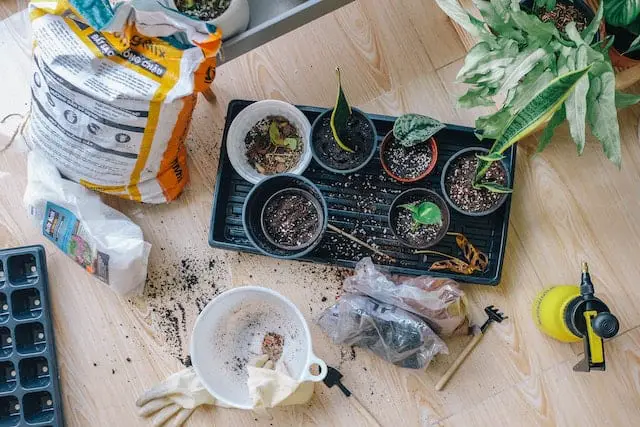Hoya Retusa is a rare, eye-catching plant with stick-like leaves that end in what look like tiny hearts. It’s a great addition to any indoor garden, but you should know the specifics of Hoya Retusa Care tips to keep this tropical beauty thriving and maybe even blooming!
A true standout in any plant collection, Hoya Retusa’s unique heart-shaped leaves and delicate blooms make it well worth the effort to keep it happy and healthy.
The most important aspect of Hoya Retusa care is to not overwater. Water only when the top half of the soil is dry. Additionally, Hoya Retusa requires bright, indirect light, well-draining soil, minimal fertilizer, and moderate humidity.
Hoya Retusa are typically easy to grow indoors, but read on for the specifics of what your Hoya needs to thrive. A happy plant can even be propagated so you can grow additional plants. Read on for everything you need to know.
What Must I Know About Hoya Retusa Care?

1. Don’t Overwater
Hoya Retusa can be an excellent plant for beginner gardeners because it can go for long periods without needing water. If you are tempted to overwater your plants, however, you may have to resist the urge with the Hoya Retusa.
The rule of thumb is to only water when the top half of the soil is dry. You will find that the soil may dry out more quickly in certain conditions, such as in dry climates or very bright locations.
How frequently you water will also depend on how much drainage you have in your pot and soil. In the summer, you may be watering around once every 1-2 weeks. In the winter, when the plant is not growing, you will probably have to water less.
A good way to water plants like Hoya is to completely soak the soil and let the excess water drain out of the drainage holes. You can do this outdoors or in your kitchen sink or bathtub. This will ensure that the roots of your plant are completely and evenly soaked. You may need to soak the plant more than once to make sure all the soil is damp.
Some gardeners recommend distilled or rainwater for Hoya. If your plant isn’t thriving, try skipping the tap water or letting tap water sit out overnight before watering.
2. Provide Adequate Drainage
Hoya Retusa roots cannot sit in damp soil for a long time before developing root rot. If you notice black or brown patches on your roots, or you smell a rotting smell from some of the roots, your plant has developed root rot.
When the roots are damaged, the plant cannot absorb adequate water and nutrients, and you will see the leaves start to turn yellow or brown.
Root rot can be prevented with adequate drainage. Make sure your pot has at least one drainage hole in the bottom. Never let your plant sit in a dish of water–it will not be able to absorb excess water.
If you are having problems with drainage, you may want to switch from a plastic, metal, or glazed pot to a terracotta pot, which will provide better evaporation.
3. Use Well-Draining Soil

Along with having the correct pot, having the correct soil will help your Hoya Retusa avoid root rot. Hoya may do ok in regular potting soil, though if you have a hard time getting the soil to dry adequately, you may need to add in some extra coarse material for drainage.
You can start with regular potting soil and add in half cactus or succulent soil, which will provide drainage and aeration. You can also add coarse sand, perlite or coconut coir to potting soil to increase drainage. You can purchase all of these materials at gardening stores.
If you notice mold growing on your soil, you will definitely need to repot into better-draining soil.
4. Keep in Bright Light; Avoid Intense Sun
Hoya Retusa isn’t too picky about light and can thrive in a wide variety of lighting conditions. It generally won’t grow well in very low light conditions. If you only have low light and are desperate to grow a Hoya Retusa, you can use a grow light to provide additional light.
Likewise, Hoya Retusa will get sunburned in very intense direct sun. If you notice your leaves are curling or browning, your plant may be getting too much light. Morning sunlight seems to be better than intense afternoon sun.
The best place for a Hoya Retusa is in a bright window or set slightly away from a sunny window. If growing outdoors for part of the year, you can place under an awning or in a place that will not see sun all day long.
Mature Hoya Retusa may bloom in beautiful white stars, though the plant will most likely need long days of bright light to do so.
5. Avoid Cold Temperatures

Hoya Retusa is a tropical plant that doesn’t tolerate frost or cold temperatures. Other than that, they are pretty well-adapted to most indoor environments. Keep your plant in temps ranging from 50-80℉.
If you live in a cold climate and are growing your plant outdoors, make sure to keep an eye on the night temps so your plant isn’t exposed.
Hoya often doesn’t tolerate temperature fluctuations. If you are moving your plant frequently, or if it is by HVAC vents or drafty windows, you may notice stunted growth or yellowing leaves.
6. Pest and Disease Management for Hoya Retusa
While Hoya Retusa is generally a hardy plant, it can still face a few pests and diseases. Common pests that may affect this plant include mealybugs, aphids, and spider mites. Regularly inspect your plant for signs of infestation, such as sticky residue, webbing, or distorted leaves.
Treat any pest issues promptly using organic insecticidal soap or neem oil, following the product instructions carefully. As for diseases, overwatering and poor drainage can lead to root rot. To prevent this, ensure proper watering practices and provide well-draining soil.
If you notice signs of root rot, such as yellowing leaves and a foul smell, take immediate action by improving drainage, repotting into fresh soil, and trimming affected roots. Maintaining a clean and healthy growing environment, along with regular inspections, will help keep your Hoya Retusa pest and disease-free.
7. Repot Every 2-3 Years

Hoya Retusa doesn’t need to be repotted very frequently, and can tolerate being a little bit pot bound. That being said, it is a good idea to repot most indoor houseplants every other year or so.
Make sure you use fresh soil. If you want your plant to grow bigger, you can repot into a new pot that is 2-3 inches larger than the old one. If you don’t want a bigger Retusa, you can divide yours. Just pull apart the roots and stems of your original plant and repot in small pots in fresh soil.
This plant is so easy to grow you may want one in every room!
This is best done in early spring for faster growth, but it can be done any time your plant is root bound or needs repotting.
8. Pruning and Maintenance Tips
Regular pruning and maintenance are important aspects of Hoya Retusa care to keep the plant in optimal condition. Pruning can help maintain a compact shape and promote healthy growth. Remove any dead, damaged, or yellowing leaves by gently pinching them off.
Trimming back leggy or unruly stems can also encourage bushier growth. Use clean and sharp pruning shears to prevent any damage or disease transmission. Additionally, remove any debris or fallen leaves from the pot or around the plant to maintain cleanliness and prevent pest issues.
Regularly inspect the plant for signs of pests or diseases and address any issues promptly. By incorporating regular pruning and maintenance into your care routine, you’ll keep your Hoya Retusa looking neat and vibrant.
9. Propagation Techniques for Hoya Retusa

Propagation is an exciting way to expand your Hoya Retusa collection or share this beautiful plant with others. There are a few techniques you can try to propagate your Hoya Retusa successfully. One popular method is stem cutting propagation.
Select a healthy stem with a few leaves and make a clean cut just below a leaf node. Remove the lower leaves, leaving a few at the top, and place the cutting in a well-draining potting mix.
Keep the soil slightly moist and provide indirect light. Over time, roots will develop, indicating successful propagation. Another method is water propagation, where you place the cut stem in a container of water and wait for roots to form before transferring it to soil. Both methods require patience and proper care to ensure the new plants thrive.
Seasonal Care for Hoya Retusa
Different seasons require slight adjustments in care to accommodate the changing needs of Hoya Retusa. During the active growth period in spring and summer, the plant may require more frequent watering as it utilizes more energy.
Monitor the soil moisture and adjust your watering schedule accordingly, ensuring the top half of the soil is dry before watering. Additionally, provide adequate humidity by misting the leaves or using a humidifier. In contrast, during the winter months, when the plant is in a dormant phase, reduce watering frequency to avoid over moist soil.
Protect the plant from cold drafts and temperature fluctuations by keeping it away from windows or heating vents. By adjusting care practices to the specific seasonal needs, you can ensure the long-term health and well-being of your Hoya Retusa.
Learn more from a similar post: Begonia Maculata Propagation
Conclusion
Hoya Retusa adds a unique dimension to any home garden–and chances are it looks harder to grow than it is! You can keep this impressive plant alive and well by following these easy Hoya Retusa care steps.
Frequently Asked Questions
Is Hoya Retusa a Fast Grower?
In good conditions, with ample bright light, it will grow moderately fast. You can use diluted fertilizer (start with half-strength) to aid growth, though many Hoya grow without it.
How Often Should I Water My Hoya?
Only when the top half of the soil is dry. This may be as infrequently as every 2-4 weeks in the winter. In the summer growing season you will need to water more frequently.
Should I Mist My Hoya?
Hoya is a tropical plant that doesn’t like to dry out. If you live in a very dry climate, you may want to add more humidity. The best way to do this is to use a room humidifier or a pebble tray filled with water (don’t let the plant sit in water). You can also put your plant in a bathroom or kitchen.
You can also mist your plant occasionally, just make sure water isn’t pooling on the leaves and it isn’t over watered.

Hey, I’m Lisa and I’ve been an avid gardener for over 30 years. I love writing, talking and living in the garden! Feel free to connect with me on my socials below

